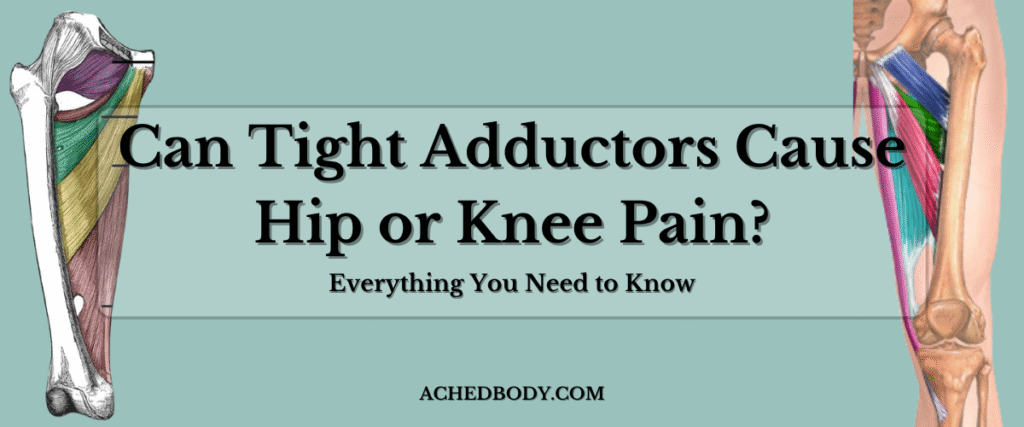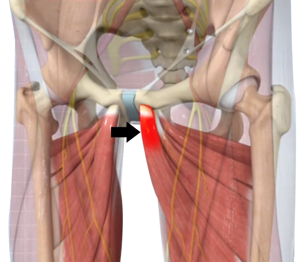
Can Hip and Knee Pain Come From Your Adductors?
If you stretch your groin and feel discomfort or pain in your hips… or all the way to your knees, your adductors may be to blame.
Of course it’s never that black and white. Tight adductors — the muscles on your inner thighs – are one of the many muscles that can cause hip and knee pain.
But it’s important to test and find out the root cause.
In this article, I’ll explain:
How adductor tightness affects your hips and knees
The signs of a deeper imbalance
The most effective ways I know to fix it
Understanding the Adductor Muscles

The adductors are a group of muscles that run along the inner thigh and attach at your pelvis and femur. They include:
- Adductor longus
- Adductor brevis
- Adductor magnus
- Gracilis
- Pectineus
You don’t have to memorize this, but it helps to understand that some muscles are longer, some go over the knee joint and some are only in the upper leg area, closer to the hip.
This will help you target them with trigger point therapy better, depending on your pain location.
The main purpose of the adductors is to pull your legs inward (think squeezing your thighs together).
But when these muscles become tight and full of trigger points, they can alter how your pelvis and legs move — putting stress on nearby joints and other muscles like your Hamstrings.
And that’s why I preach trigger pointing and stretching your adductors to get full relief!
How Tight Adductors Affect the Hips

Your hips are the anchor point for your adductors. When these muscles are restricted, there is stress that gets transferred to the pelvis.
Your hips can tilt or rotate unevenly, become compressed, lose mobility, and other muscles like the hip flexors or glutes have to pick up the slack.
This means that you will begin to experience pain in the front or side of the hip.
You may also start to experience clicking or catching during leg movements and decreased range of motion when squatting or lunging.
That’s why I made my adductor trigger point guide and the stretching guide to help reverse this problem!
Why Knee Pain Can Be a Groin Problem
The adductors don’t just attach at the pelvis — some (like the adductor magnus) insert near the knee.
This is one reason why a lot of people feel knee pain on the medial external knee.
All of the muscles that cross the knee joint play a role in making sure that there is stability, but if they are too tight, they will pull the knee out of alignment and cause pain.
Learn more about hamstring caused knee pain or quad related knee pain with these articles!
For the adductors, they can pull the femur inward, changing your leg alignment.
They also tend to aggravate the bursa and other muscles of the “pes anserinus”, leading to inflammation and pain in everyday activities.
If you’ve been stretching your hamstrings or quads with no relief in your knee or hip, tight adductors might be the real issue.
You also may need to check your calves for your knee, and your glutes or hip flexors for your hips.
Learn about trigger pointing your lower body and pair that with targeted stretches in my ultimate guide to stretching.
Signs Your Groin Pain Is Linked to Muscle Tightness
Chronic muscle tightness in your groin is different from an acute groin strain or tear.
If there was a sharp, sudden pain during exercise, then that is a much bigger issue that will require rest to heal and then therapeutic help after the muscle has repaired itself.
But for many people, the problem is chronic tightness or overuse.
Look out for:
- Stiffness or tenderness in the inner thigh above and beyond it being a sensitive area of the body
- Groin pain during walking, lunging, or side-to-side movement
- Clicking hips or limited range of motion when abducting the leg (moving out to the side)
- Discomfort during groin stretches
- Inner thigh soreness (even without recent activity)
You can test for adductor sensitivity with my foam rolling guide to see if more treatment is necessary.
If foam rolling helps, I suggest working in more foam rolling, or trigger point therapy for the adductors and specific stretches to loosen the area found in this stretching guide.
Treating Tight Adductors: A 3-Part Plan
If you are ready to bulletproof your adductors and fix the cause of your pain, Here’s the roadmap:
1. Release the Tightness
Step one is releasing the tightness. This can take some time, but consistent action for a week will get rid of your pain or greatly reduce it:
And if you want to progress further add in:
Don’t force aggressive stretching — instead, use slow, longer holds and deep breathing.
2. Correct the Imbalance
If one side is tighter than the other, your pelvis may be misaligned.
If you don’t fix this, the issue is going to come back.
So doing corrective exercise on your adductors through full range of motion will help (coming soon).
3. Improve Your Movement Patterns
Focus on how you move.
Try retraining your body to use proper form during squats and lunges, avoid valgus collapse (knees caving inward) and build stability with unilateral exercises (like copenhagen planks).
When to See a Professional
If your pain is sharp, or is above and beyond aches and soreness, you might need professional help.
A physical therapist or sports medicine professional can evaluate whether you’re dealing with:
- A true groin strain
- Adductor tendinopathy
- A pelvic or hip alignment issue
- Referred pain from a deeper trigger point
Now What?
If you want more actionable advice, look at the stretching guide for adductors and the foam rolling guide for adductors.
If neither of those help your joint pain, there are other muscles that may be the culprit.
Visit my Ultimate Guide to Trigger Point Therapy and my Ultimate Guide to Stretching to get more information!
Good Luck!
-Nick